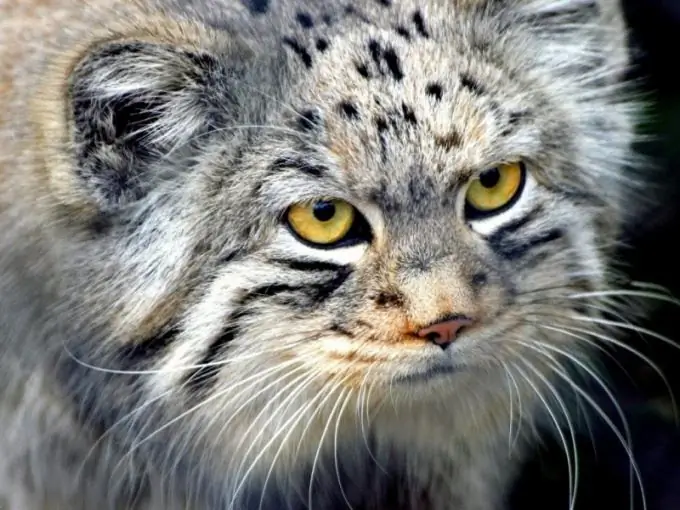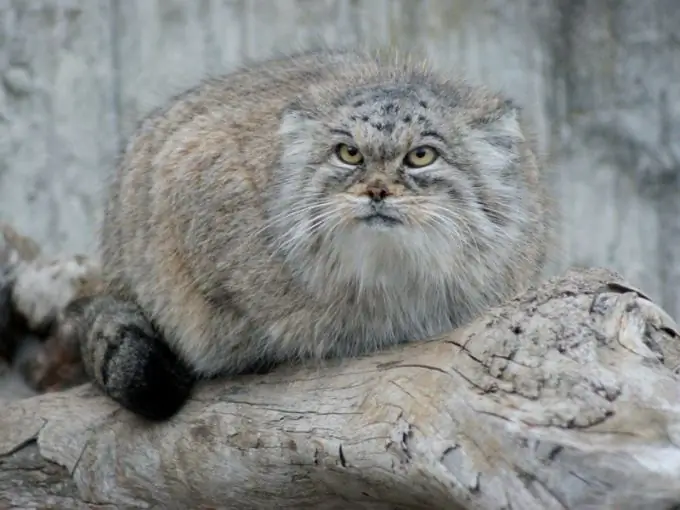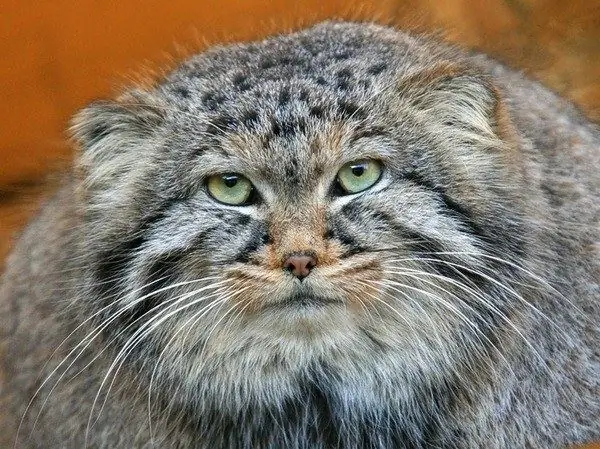- Author Delia Mathews [email protected].
- Public 2023-12-16 00:05.
- Last modified 2025-01-22 15:45.
Recently, unusual representatives of the cat family - Pallas' cat, also known as palassovy cats, are gaining more and more popularity. Outwardly resembling ordinary cats, they have a number of distinctive properties.

Pallas cat's appearance

The size of the Pallas' cat is slightly larger than that of ordinary domestic cats. The body length of an adult animal is from 50 to 65 centimeters, the tail can be from 23 to 30 centimeters or more. Pallas' cat weighs, on average, 2-5 kilograms.
Pallas' cat got its second name in honor of the German scientist Peter Pallas, who in the 18th century was the first to describe these predators that lived on the shores of the Caspian Sea.
Pallas' cat is easy to distinguish from ordinary cats due to its more dense and massive build: a strong muscular body and short thick legs allow the animal to hunt. Thick wool protects and adorns the animal. According to scientists, in one square centimeter of the body surface of a manul can fit about 9000 hairs, reaching a length of about 7 centimeters.
If at an early age kittens are very similar to the cubs of ordinary domestic cats, noticeable differences begin to appear with age. In particular, the head, which has a special structure, looks different, and the pupils of yellow eyes do not become flat in bright light, maintaining a round shape. Pallas' cat is also characterized by special bundles of wool on the cheeks - the so-called tanks.
According to scientific research, among the cat family, Pallas' cat is the leader in the density and fluffiness of fur. The color of these animals is basically the same and consists of a bizarre combination of hairs of light gray and pale ocher shades. Due to the fact that each hair has a white tip, when looking at the manul, it seems that it is slightly dusted with snow.
Behavior and habits of wild Pallas' cat

In natural conditions, wild Pallas' cat live in the territory of Central and Central Asia, most often they are found in areas with little snow. Typically, these animals choose to live in steppe or semi-desert areas in the mountains, they are also found in hummocks and intermontane basins. Pallas are especially fond of the area with shrub thickets and stone placers, as well as rocky crevasses. Scientists have managed to record that Pallas' cat is able to rise to the level of 3000-4800 meters
Pallas' cat is most active in the early morning and at dusk. Animals, as a rule, create their lair in rock crevices or small caves, as well as under stones. There are cases when Pallas' cat adapted for themselves old burrows made once by marmots, badgers and even foxes.
There are suggestions that Pallas' cat are distant relatives of Persian cats. Defenders of this theory rely on a number of similar features (fluffy coat, rounded shape and unusual head shape).
These wild cats hunt, usually concealing prey or waiting by stones and minks. During the hunt, Pallas' color is very helpful, which is an excellent camouflage. At the same time, according to zoologists, these animals can be considered the slowest and most clumsy of wild cats. It is almost impossible to see a fast running manul, usually he moves slowly. Sensing danger, animals prefer to hide or climb stones and rocks in order to hide from a possible enemy. Alarmed animals emit a characteristic hoarse rumbling, and also snort sharply, resembling the behavior of domestic cats.
Pallas' cat prefers to feed most often on pikas and other types of murine rodents. However, there are cases when animals managed to catch gophers, marmots, birds and even tolai hares. In summer, Pallas' cat can also eat various insects.
Interesting facts about manula

In the opinion of a number of ethnographers, many tales and riddles about cats among the peoples of Central and Central Asia are dedicated specifically to the Pallas' cat - quite often in folklore collections you can see the image of a lazy and clumsy animal, capable of guarding prey for hours and quickly hiding at the first sign of danger. This characteristic is indeed very suitable for this type of feral cat.
The image of a manul has recently been increasingly used for a variety of purposes. One of the most famous symbols is the Pallas' cat on the emblem of the Moscow Zoo.

